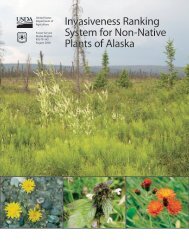Arctic fox - Alaska Natural Heritage Program - University of Alaska
Arctic fox - Alaska Natural Heritage Program - University of Alaska
Arctic fox - Alaska Natural Heritage Program - University of Alaska
Create successful ePaper yourself
Turn your PDF publications into a flip-book with our unique Google optimized e-Paper software.
<strong>Alaska</strong> Species Ranking System Summary Report - <strong>Arctic</strong> <strong>fox</strong><br />
Number <strong>of</strong> Young (-5 to 5)<br />
Average litter size 7 pups (Stephenson 2008).<br />
1<br />
Ecological Specialization<br />
Dietary (-5 to 5)<br />
Omnivorous. In the summer, feeds primarily on small mammals, including lemmings and tundra voles. If denning near the<br />
seacoast, <strong>of</strong>ten depends on seabirds, such as auklets, puffins, and murres. Also feeds on berries, eggs, marine invertebrates,<br />
fish, and scavenged remains <strong>of</strong> other animals (Audet et al. 2002, Stephenson 2008).<br />
Habitat (-5 to 5)<br />
Found in arctic tundra, along rocky beaches, and far out and widely dispersed on the frozen ice. Prefers to den in light,<br />
sandy soil along riverbanks, on small hillocks, and occasionally in talus (MacDonald and Cook 2009).<br />
Biological Total:<br />
-5<br />
-5<br />
-38<br />
Action<br />
- variables measure current state <strong>of</strong> knowledge or extent <strong>of</strong> conservation efforts directed toward a given taxon. Higher<br />
action scores denote greater information needs due <strong>of</strong> lack <strong>of</strong> knowledge or conservation action. Action scores range<br />
from -40 (lower needs) to 40 (greater needs).<br />
Management Needs (-10 to 10)<br />
No direct management. Open to trapping and sport hunting (ADFG 2009, ADFG 2010c). Eradication efforts are eliminating<br />
nonnative <strong>fox</strong>es from islands (Ebbert and Byrd 2002, Gibson and Byrd 2007, Williams et al. 2003).<br />
Monitoring Needs (-10 to 10)<br />
Not monitored, some information available from trapper questionnaires (ADFG 2007f).<br />
Research Needs (-10 to 10)<br />
<strong>Arctic</strong> <strong>fox</strong> populations rise and fall with cyclic changes <strong>of</strong> their prey. When food is scarce, fewer pups are successfully reared<br />
to maturity and competition among pups for food accounts for some mortality <strong>of</strong> that age group (Stephenson 2008). Local<br />
fluctuations in numbers are caused mainly by reproduction <strong>of</strong> local animals, juvenile survival, and immigration. Rabies is an<br />
enzootic in most populations, and periodic epizootics have occurred in most mainland populations. Trapping and hunting are<br />
important causes <strong>of</strong> mortality where humans co-occur (Audet et al. 2002).<br />
Survey Needs (-10 to 10)<br />
1341 records in Arctos (Arctos 2007). Information from trapper questionnaires (ADFG 2007f). Nonnative range on islands<br />
known. Habitat associations, home ranges, and movement studied by Anthony (1997) in western <strong>Alaska</strong>. Studied in areas <strong>of</strong><br />
oil development on North Slope (Eberhardt et al. 1982).<br />
Action Total:<br />
Score<br />
10<br />
10<br />
-10<br />
-10<br />
0<br />
Supplemental Information<br />
Harvest:<br />
Seasonal Occurrence:<br />
Taxonomic Significance:<br />
Range Map<br />
- variables do not receive numerical scores. Instead, they that are used to sort taxa to answer specific<br />
biological or managerial questions.<br />
Substantial, regulations<br />
Year-round<br />
% Global Range in <strong>Alaska</strong>:


















